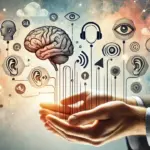Introduction
In today’s fast-paced digital age, understanding and managing our emotions is more crucial than ever. Whether you’re a student, a therapist, a coach, or even a housewife, emotional intelligence plays a pivotal role in every interaction and decision. But how can we enhance this vital skill? Enter Neuro-Linguistic Programming (NLP) – a transformative approach that bridges the gap between communication, personal development, and psychotherapy. For those unfamiliar with NLP, it might sound like a complex tech term. However, its principles are deeply rooted in understanding human behavior and emotions. This blog aims to unravel the power of **NLP for emotional intelligence** enhancement, offering actionable insights especially tailored for those new to this domain, including professionals like coaches who are stepping into the realm of digital marketing. By integrating NLP techniques, not only can one achieve personal growth, but they can also create impactful digital marketing strategies that resonate on an emotional level with their audience. So, whether you’re looking to understand your own emotions better, or you’re a coach aiming to connect deeper with your clients in the digital space, this guide will provide you with the tools and knowledge you need. Let’s embark on this enlightening journey together!
What is NLP?
Neuro-Linguistic Programming, commonly known as NLP, is a unique approach that focuses on the relationship between language, behavior, and the mind. The term itself breaks down into three components: “Neuro” refers to the brain and its neural network, “Linguistic” pertains to language and communication, and “Programming” denotes the patterns and behaviors we learn through experience. Originating in the 1970s, NLP was developed by Richard Bandler and John Grinder as a means to understand and replicate the techniques of successful therapists. Over the years, NLP has evolved and is now widely used not just in therapy, but also in business, education, and personal development. It offers tools and techniques to understand human behavior, change limiting beliefs, and enhance communication skills. For those new to NLP, think of it as a manual for the mind, helping you navigate and optimize your emotional and behavioral responses.
Understanding Emotional Intelligence
Emotional Intelligence (EI) is the ability to recognize, understand, and manage our own emotions while also being attuned to the emotions of others. It goes beyond the realms of traditional intelligence and involves a deeper connection with our inner selves and the world around us. Daniel Goleman, a renowned psychologist, identified five key components of EI: self-awareness, self-regulation, motivation, empathy, and social skills. For instance, a teacher who can sense the mood of her classroom and adjust her teaching method accordingly demonstrates high emotional intelligence. Similarly, a businessman who can negotiate with empathy and understanding is leveraging his EI. It’s a skill that impacts various facets of our lives, from personal relationships to professional success. In essence, emotional intelligence is not just about being aware of emotions but effectively navigating through them to lead a balanced and harmonious life.
NLP for Emotional Intelligence
At its core, NLP provides tools and techniques that enable individuals to decode the language of their own minds. When applied to the realm of emotional intelligence, NLP becomes a powerful ally. It offers a structured approach to understanding and influencing our emotional responses, thereby enhancing our EI.
NLP techniques delve into how we internally represent emotions, the patterns we follow when processing feelings, and the linguistic cues that accompany our emotional states. For example, consider a student who gets anxious before exams. Through NLP, they can explore the internal dialogue that fuels this anxiety, identify patterns, and then reframe or replace these thoughts with more empowering beliefs.
For professionals like coaches and therapists, NLP offers a structured methodology to help clients achieve emotional balance. A coach might use NLP to help a client move past a limiting belief, such as fear of public speaking, by altering the client’s internal representation of that fear.
Furthermore, NLP practices for emotional well-being can be invaluable for everyone, from housewives managing household stresses to businessmen navigating high-stakes negotiations. By integrating NLP techniques into daily routines, individuals can not only enhance their understanding of emotions but also cultivate richer, more fulfilling interpersonal relationships.
Benefits of NLP in Understanding Emotions
Neuro-Linguistic Programming offers a plethora of benefits when it comes to understanding and managing emotions. Here are some of the most significant advantages:
1. Enhanced Self-awareness
- NLP encourages introspection. By analyzing our thought patterns and emotional responses, we become more aware of our triggers and can address them proactively. For instance, a counselor might recognize a pattern of negative self-talk in a client and use NLP to shift that narrative.
2. Improved Communication
- Understanding emotions is pivotal for effective communication. NLP techniques can help individuals articulate their feelings more clearly, leading to healthier relationships, whether it’s a teacher communicating with students or a doctor empathizing with a patient.
3. Conflict Resolution
- By recognizing and understanding the emotions at play, individuals can address conflicts more constructively. A businessman, for example, can use NLP to understand the concerns of a client, leading to more fruitful negotiations.
4. Personal Growth
- NLP provides tools to challenge and change limiting beliefs. Someone held back by a fear of failure can use NLP to reframe their perspective, viewing setbacks as learning opportunities instead.
5. Enhanced Empathy
- By understanding our own emotions better, we naturally become more attuned to the feelings of others. This heightened empathy can be invaluable for professionals like therapists and coaches, allowing them to connect more deeply with their clients.
6. Stress Management
- NLP offers techniques to understand the root causes of stress and anxiety, equipping individuals with strategies to manage and alleviate these emotions.
Incorporating NLP into one’s life can lead to profound changes, not just in understanding emotions but in overall well-being and life satisfaction. Whether you’re a housewife seeking balance or a professional aiming for growth, NLP offers a roadmap to emotional mastery.
Techniques of NLP for Emotional Growth
Neuro-Linguistic Programming is rich with techniques that can foster emotional growth. These methods, when practiced consistently, can lead to profound personal transformations. Here’s a closer look at some of the most impactful NLP techniques tailored for emotional development:
1. Anchoring
- This technique involves associating a specific physical touch or gesture with a positive emotional state. For example, a teacher feeling overwhelmed can anchor a feeling of calmness to a specific touch, like pressing their thumb and forefinger together, and use it whenever they need to access that emotion.
2. Swish Pattern
- This is a visualization technique where an individual replaces an undesirable emotion or behavior with a desired one. A therapist might guide a client to visualize their fear of public speaking, and then “swish” it with an image of them speaking confidently.
3. Reframing
- This technique focuses on changing the way one perceives an event, thereby altering the emotional response to it. A businessman facing a setback might reframe it as a learning opportunity rather than a failure.
4. Meta Model
- This linguistic tool involves asking specific questions to challenge and expand on limiting beliefs. Coaches can use the meta model to help clients explore statements like “I can’t do this,” delving deeper into the underlying beliefs and emotions.
5. Submodalities
- These are the finer details of how we internally represent experiences. By changing these details, like the brightness or size of a mental image, one can change their emotional response to it. A student anxious about exams might visualize the exam paper as small and distant, reducing its emotional impact.
6. Parts Integration
- Often, internal conflicts arise when different parts of our psyche have opposing beliefs or desires. This technique integrates these conflicting parts, leading to internal harmony. For instance, a part of an individual might seek adventure, while another craves safety. Through parts integration, a middle ground can be found.
7. Milton Model
- This involves using vague and ambiguous language to facilitate a trance-like state, allowing for deeper introspection and emotional healing.
By mastering and applying these NLP techniques, individuals can embark on a journey of emotional growth, breaking free from limiting beliefs and patterns, and embracing a life of balance, understanding, and fulfillment.
Emotional Intelligence Training with NLP
Training in emotional intelligence (EI) using Neuro-Linguistic Programming (NLP) offers a comprehensive approach to understanding and enhancing one’s ability to recognize, process, and manage emotions. Here’s how NLP can be integrated into EI training:
1. Foundation of Self-awareness
- At the heart of emotional intelligence lies self-awareness. NLP training begins by helping individuals recognize their emotional patterns, triggers, and responses. For example, a coach might use NLP techniques to help clients identify emotions they weren’t previously conscious of, paving the way for deeper self-understanding.
2. Building Empathy
- NLP emphasizes the importance of understanding others’ perspectives. Through exercises and role-playing, trainees learn to step into another’s shoes, fostering genuine empathy. This skill is invaluable for professionals like therapists and counselors, enabling them to connect deeply with their clients.
3. Effective Communication
- NLP training equips individuals with tools to express their emotions clearly and constructively. By understanding the nuances of language and non-verbal cues, trainees can communicate their feelings and needs more effectively.
4. Managing Emotional Responses
- Through techniques like anchoring and reframing, NLP training teaches individuals to regulate their emotional reactions, especially in challenging situations. A businessman, for instance, can use these tools to remain calm and composed during high-pressure negotiations.
5. Continuous Practice
- Like any skill, emotional intelligence requires consistent practice. NLP training emphasizes the importance of regular introspection, feedback, and refinement. Over time, trainees internalize these techniques, leading to spontaneous and natural emotional responses.
Incorporating emotional intelligence training with NLP provides a holistic approach to personal development. It’s not just about understanding emotions but mastering them to lead a more balanced, harmonious, and successful life. Whether you’re a student, a professional, or someone seeking personal growth, this training offers invaluable insights and tools for emotional mastery.
Role of NLP in Emotional Development
Neuro-Linguistic Programming (NLP) plays a pivotal role in fostering emotional development. As individuals navigate through life’s challenges and experiences, emotions often become the guiding force, influencing decisions, behaviors, and interactions. Here’s how NLP contributes to this crucial aspect of personal growth:
1. Unearthing Deep-seated Beliefs
- NLP techniques delve into the subconscious, helping individuals identify and address beliefs that may have been formed in childhood or through past experiences. Recognizing these beliefs is the first step towards altering them for positive emotional growth.
2. Enhancing Emotional Agility
- Life is replete with ups and downs. NLP equips individuals with the ability to adapt to varying emotional scenarios, ensuring resilience and flexibility. For instance, a counselor can use NLP to teach clients how to shift from feelings of sadness to empowerment.
3. Building Emotional Intelligence
- NLP doesn’t just focus on understanding emotions but also on cultivating the skills to manage and express them effectively. This holistic approach ensures that individuals are not only in tune with their feelings but can also navigate interpersonal relationships with empathy and understanding.
4. Promoting Self-awareness and Reflection
- Through techniques like reframing and the meta model, NLP encourages introspection. This continuous self-reflection is vital for emotional development, allowing individuals to grow, evolve, and lead fulfilling lives.
In essence, NLP serves as a compass, guiding individuals on their journey of emotional development, ensuring they lead lives of balance, understanding, and profound personal growth.
NLP Strategies for Better Emotional Health
Emotional health is integral to overall well-being, influencing everything from interpersonal relationships to professional success. Neuro-Linguistic Programming (NLP) offers a suite of strategies designed to bolster emotional health, ensuring individuals lead balanced and fulfilling lives. Here are some key NLP strategies:
1. Visual Anchoring
- This technique involves associating a positive emotion with a specific visual cue. Whenever one encounters this cue, it triggers the associated emotion, serving as a quick mood booster.
2. Positive Reframing
- Instead of dwelling on negative experiences, this strategy encourages viewing challenges as opportunities. For example, viewing a job loss not as a setback but as a chance to explore new avenues.
3. Dissociation Technique
- When faced with overwhelming emotions, this strategy involves mentally stepping out of the situation and viewing it as an objective observer. This detachment can provide clarity and reduce emotional intensity.
4. Belief Examination
- NLP encourages questioning and examining deeply held beliefs. By challenging these beliefs, one can replace negative thought patterns with more constructive ones.
5. Modeling
- This involves observing and emulating individuals who exhibit strong emotional health. By adopting their behaviors, thought patterns, and strategies, one can cultivate better emotional well-being.
Incorporating these **NLP strategies for better emotional health** into daily routines can lead to significant improvements in mood, resilience, and overall emotional balance. Whether facing daily stresses or larger life challenges, these tools offer a roadmap to emotional equilibrium.
Improving Emotional Intelligence Using NLP Methods
Neuro-Linguistic Programming (NLP) offers a treasure trove of methods to enhance emotional intelligence (EI), a key factor in personal and professional success. Here’s how one can harness NLP for EI improvement:
1. Internal Dialogue Shift
- NLP teaches individuals to be mindful of their internal conversations. By transforming negative self-talk into empowering affirmations, one can boost self-awareness and self-regulation.
2. Empathy Development
- Through mirroring and rapport-building exercises, NLP enhances one’s ability to understand and resonate with others’ emotions, strengthening interpersonal relationships.
3. Emotion Elicitation
- NLP techniques, like anchoring, allow individuals to evoke and harness positive emotions at will, aiding in better emotional response management.
4. Goal Setting
- By visualizing desired emotional states and setting clear emotional goals, NLP provides a path to achieve higher levels of emotional intelligence.
In essence, by integrating NLP methods into daily practices, individuals can significantly elevate their emotional intelligence, leading to enriched personal interactions and greater self-understanding.
NLP Practices for Emotional Well-being
Emotional well-being is the cornerstone of a fulfilling life, influencing our relationships, work, and overall happiness. Neuro-Linguistic Programming (NLP) offers a range of practices designed to nurture and enhance emotional well-being. Here are some pivotal NLP practices to consider:
1. Swish Technique
- This visualization practice helps replace negative emotions or behaviors with positive ones. For instance, replacing feelings of anxiety with confidence before a public speaking event.
2. Timeline Therapy
- By revisiting past experiences and altering our perception of them, this practice helps heal old emotional wounds, allowing for a more positive present and future.
3. Circle of Excellence
- This technique involves visualizing a circle filled with positive energy and emotions. Stepping into this circle whenever needed can provide an instant boost of positivity and confidence.
4. Perceptual Positions
- This practice encourages viewing situations from three different perspectives: self, another person, and an objective observer. This multifaceted view fosters empathy, understanding, and better emotional responses.
5. Meta Mirror
- This technique helps in understanding and resolving conflicts. By visualizing oneself interacting with another person, one can gain insights into the emotions and motivations of both parties.
6. Resource Anchoring
- This involves associating a resourceful emotional state, like calmness or happiness, with a specific gesture or touch. Activating this anchor in challenging situations can help evoke the desired emotion.
7. Collapsing Anchors
- This practice is used to neutralize negative emotions by triggering a positive emotion simultaneously until the negative feeling diminishes.
Incorporating these **NLP practices for emotional well-being** into daily life can lead to profound emotional balance, resilience, and a deeper connection with oneself and others. Whether navigating daily stresses or seeking long-term emotional growth, NLP provides the tools for a harmonious emotional journey.
Conclusion
Embracing Neuro-Linguistic Programming (NLP) offers a transformative journey towards enhanced emotional intelligence and well-being. Its techniques and practices provide a roadmap to navigate the intricate landscape of emotions, fostering self-awareness, empathy, and resilience. Whether you’re a student, professional, or someone seeking personal growth, integrating NLP into your life can unlock doors to deeper emotional understanding and harmony. As we conclude, remember that emotional mastery is an ongoing journey, and with NLP as a guide, the path becomes clearer, leading to a life filled with balance, understanding, and fulfillment.










